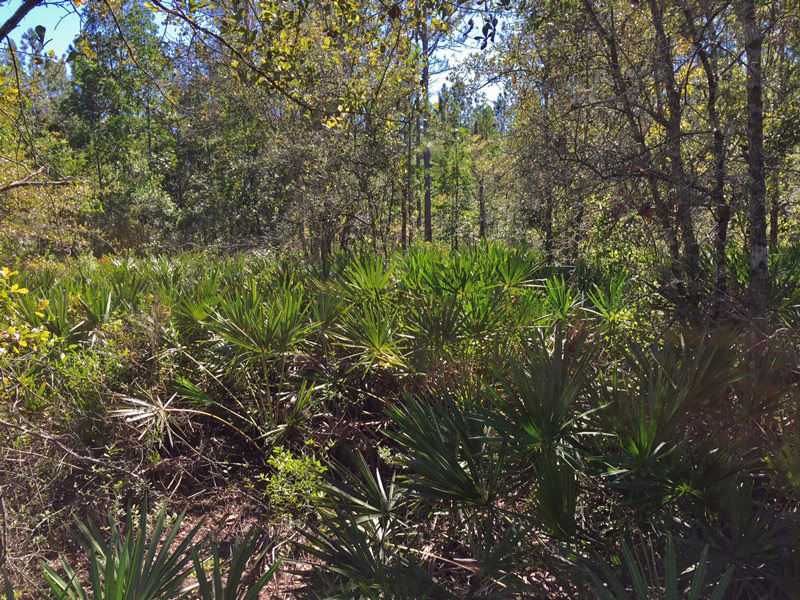
I recently received a quite interesting question in my inbox relating to pine scrub food and Florida food forest planning:
David,
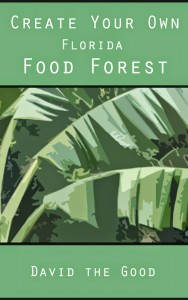 I recently found your books, bought and read the (ones) for Florida, and have handed them off to my home school children to get them started! We were blessed and got a great deal on some 15 acres – 3 is wetland – in St. Augustine surrounds. The uplands was cut and left to regrow about 30 years ago. I’m struggling with palmettos everywhere.
I recently found your books, bought and read the (ones) for Florida, and have handed them off to my home school children to get them started! We were blessed and got a great deal on some 15 acres – 3 is wetland – in St. Augustine surrounds. The uplands was cut and left to regrow about 30 years ago. I’m struggling with palmettos everywhere.
I have a small tractor and have been bush hogging some – and now know I could use this for compost – but overall I have acres of palmettos – and a VERY SMALL tractor lol. I have called to have the land pillaged to dirt, and this is very expensive – and I’m not sure ideal after reading your works. I’ve also looked at chemicals – maybe planting as I went to roll in as I try to poison them – but it takes horrible poison, and lots, and I want to grow food…
I searched your site (not yet your videos).
If you have written on how to start a food forest from solid palmettos, I’d like to read it.
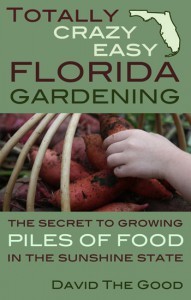 Your time is precious, and you can’t answer all the emails – and I feel guilty even dipping into your time – but I’m hoping you may already have a simple answer that is different than the rest. I’d rather have acres of food forest. I have time – I have only just found your thoughts, and will be fixing the area I have cleared (with my daughter taking the guiding role – why not, talk about random!). It will be beautiful – but right now I have about an acre clear with all the rest palmetto (though I’m searching your notes for an image guide to find the good that must be mixed in out there).
Your time is precious, and you can’t answer all the emails – and I feel guilty even dipping into your time – but I’m hoping you may already have a simple answer that is different than the rest. I’d rather have acres of food forest. I have time – I have only just found your thoughts, and will be fixing the area I have cleared (with my daughter taking the guiding role – why not, talk about random!). It will be beautiful – but right now I have about an acre clear with all the rest palmetto (though I’m searching your notes for an image guide to find the good that must be mixed in out there).
So the specific question: do you know of a decent way to either eliminate palmettos without going nuclear, or rolling them back somehow to get to food-forest state?
If you don’t have time for specific questions, I’ll still be a fan – and understand – so peace, and keep spreading the good news and writing books even my kids enjoy reading!
Les V.
St. Augustine Fl
Les also wrote a couple of follow-up emails and sent me photos of what they are dealing with:
(It looks) mostly like this – lots of palmettos, islands of gallberry(?) and small trees, pines.
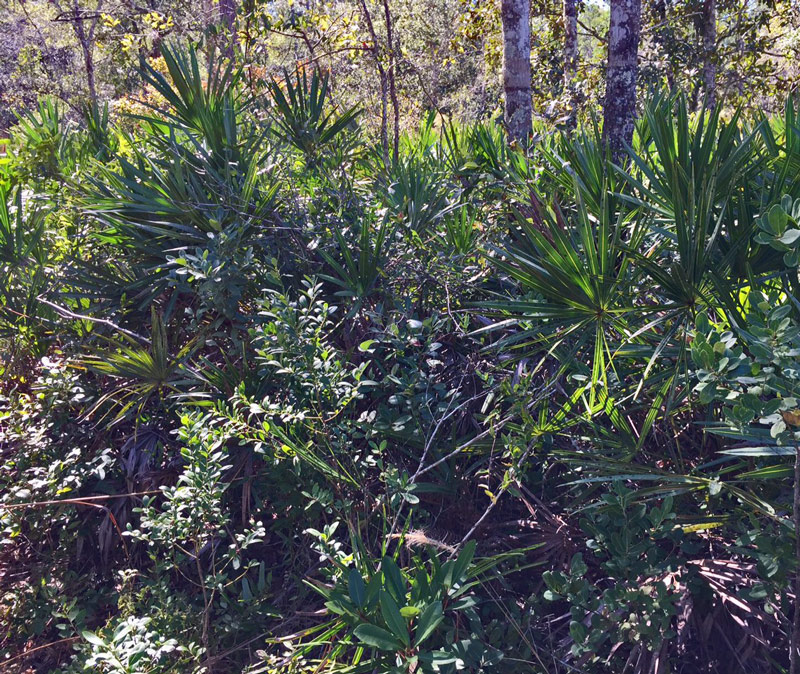
I’m using your books and videos trying to entice my daughter into loving this stuff – is there a Florida image heavy field guide? We would like to know what treasures might already be here – hard to know which to buy. It may be on your site – I will look.
Some places you must machete thru, but most has trails. Only one bad/aggressive snake (water moccasin) killed to date – in wetland. Rattlesnakes avoid us.
I bought almost no sod, but did plant Bahia around the house in “normal” fashion – where I have planted trees they have not grown – I’ll start feeding them. Soil is sandy, has clay, and is often wet 30″ down due to clay.
Would like to start large trees in front, not sure what – would love pecan, but don’t know if the possible wet feet ends that. Some medium live oaks – I have found 36-40″ stumps at near ground level rotting from their razing some thirty or more years ago. Jerks could have planted something – but then I wouldn’t have afforded the land!
Thanks for your thoughts, I will watch your site!
A lot to cover here but I’m going to give my unvarnished opinion on converting this land to food forest, though Les may not be happy.
First let’s analyze what nature is doing here, so ask the question:
What Type of Ecosystem Is This?
The answer is “Pine Flatwoods.”
This type of ecosystem is quite common in Florida and has its own rough beauty.
“Pine flatwoods are characterized by:
- low, flat topography
- relatively poorly drained, acidic, sandy soil
- and in the past, by open pine woodlands with frequent fires.
The USDA Soil Conservation Service classification system divides the pine flatwoods into two distinct groups:
North Florida flatwoods are typically open woodlands dominated by pines. This ecosystem is most commonly used as woodlands (timber, wildlife, recreation, etc.).
South Florida flatwoods are typically savannas, a type of vegetation community intermediate between grassland and forest. This ecosystem is used extensively for range (cattle grazing).”
Les has some aspects of both ecosystems in my opinion.
There are dense areas:
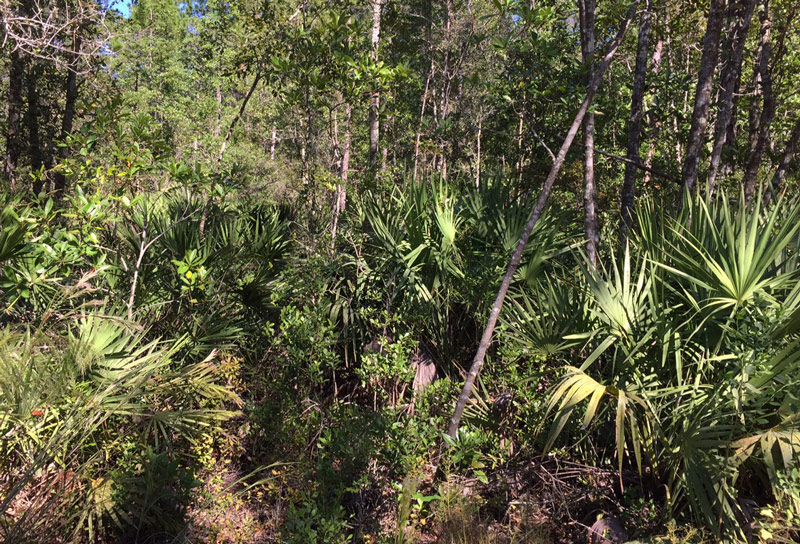
And more open areas:

Unfortunately, this is a very difficult environment for most fruit trees and vegetables.
The soil is acid and the alternating dry and wet of baking-hot sugar sand and sodden clay can wreak havoc on root systems.
Even the weeds don’t really look happy in most Pine Flatwoods.
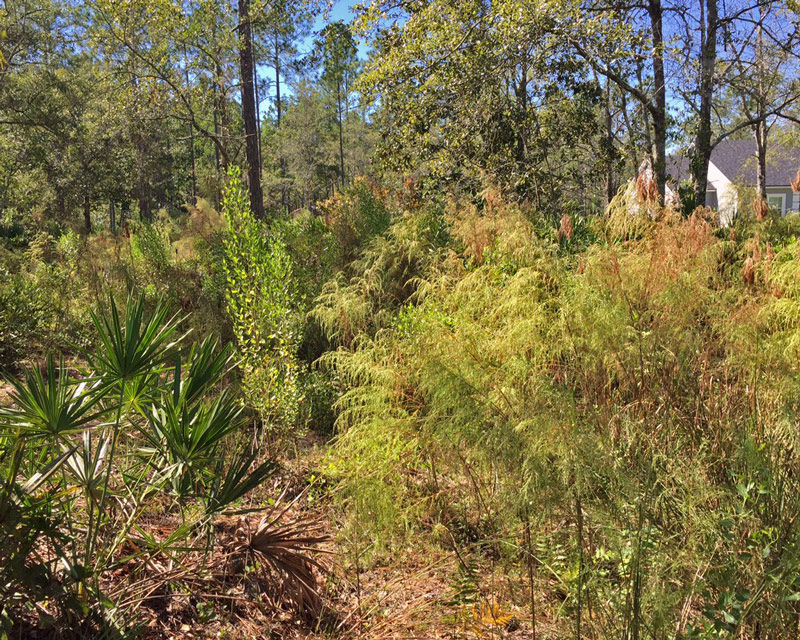
The happiest plants you’ll see are usually the pines, turkey oaks and of course, the palmettos along the ground.

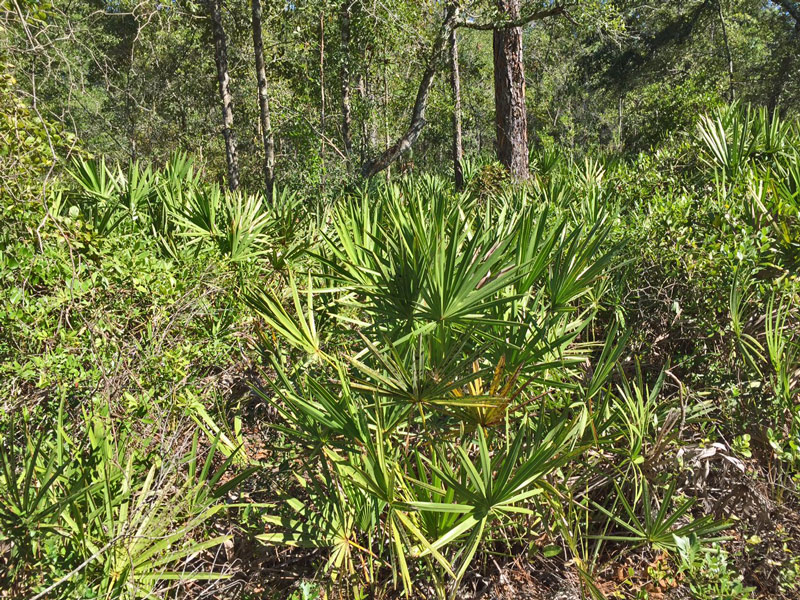
You can only push nature so far without having a serious uphill battle on your hands. I urge people to “buy the soil,” then the house, if they are interested in gardening.
This is a beautiful piece of property but it is, frankly, a rough row to hoe for building food forests and gardens. Not that it’s impossible – it’s just that the construction of the soil and its nature fights against growing most of the pampered food-producing trees and plants we love.
Should It Be Cleared?
I would argue no, except for perhaps the acre you are working on. I don’t see any reason to take down all the palmettos (or even many of them) in order to try out a food forest. Instead, I would conduct more testing near the house with various species of trees. Les remarks that the fruit trees currently there are not growing – this does not surprise me! The ground is not good for most fruit trees. Don’t expand into new areas until you really figure out how to conquer a small piece of this ground. Your hard work will likely come to naught as the palmetto re-conquer and the trees fail due to harsh conditions.
Instead, if this were my property, I would cut some nice trails through to interesting areas and let nature run free all around the edges. Up close to the house I would do some major composting. I would also have the soil analyzed for nutrients by a good lab, then do exactly what they say to amend it around the fruit trees.
If truckloads of tree mulch from another environment could be found – like a live oak/hickory/wild plum/bay hardwood forest – I would dump those in a quarter to half-acre area a foot deep and start my food forest experiments there. Do a whole acre if you desire, but know it will be hard work!
Whatever you do, DO NOT bring in any manure, hay or straw – or even factory compost – as they can all poison the land for a long time.
My friend The Scrubland Avenger has done some deep mulching and made a pretty darn nice garden in a scrub area similar to Les’s. It took a lot of work, though – and the trees farther out struggle.
Is There Anything Worth Foraging Here?
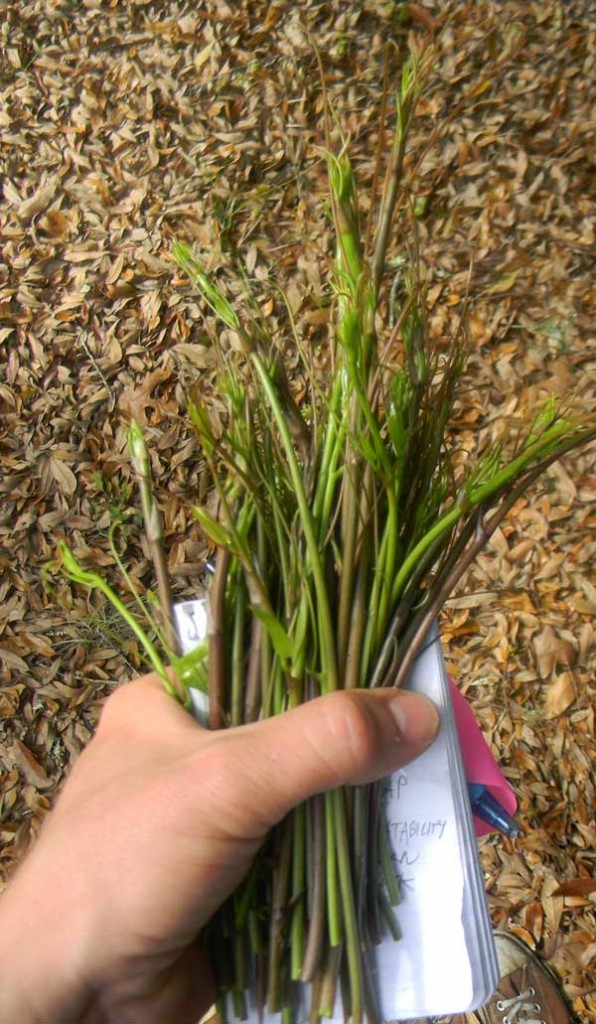
Yes, fortunately.
I have led foraging walks in scrubby areas and in pine flatwoods. The best wild edibles are blueberries and their edible berry relatives, along with occasional native passionfruit (Passiflora incarnata).
Sometimes you find good edible cactus as well, plus some edible yucca, pawpaws and maybe even the occasional persimmon tree.
Hawthorn may also be present, with their fruit being good for jam and their trunks being a possible rootstock for pear. I also often get smilax and even wild grapes occasionally.
Before you cut anything down, hunting over and over again until you really know the land is a good idea.
In the article quoted earlier, UF also mentions these species as being in the Pine Flatwood ecosystem (which meshes perfectly with my own observations):
Four Dominant Trees Characteristic of Flatwoods
- slash pine (Pinus elliottii var. elliottii)
- south Florida slash pine (Pinus elliottii var. densa)
- pond pine (Pinus serotina)
- longleaf pine (Pinus palustris)
Understory Shrubs
- saw palmetto (Serenoa repens)
- gallberry (Ilex glabra)
- fetterbush(Lyonia lucida)
- wax myrtle (Myrica cerifera)
- dwarf live oak (Quercus minima)
- tarflower (Befaria racemosa)
- blueberries / heath (Vaccinium spp.)
Minor or Infrequent Hardwoods
- live oak(Quercus virginiana)
- water oak(Q. nigra)
- sweet gum (Liquidambar styraciflua)
- red maple(Acer rubrum)
- ash (Fraxinus spp.)
As you probably noticed, most of these are not particularly edible, though you can eat palmetto fruit if you really desire to do so.
You can usually manage to hunt some game in the Pine Flatwoods, too. That’s a bonus.
Florida Foraging Books
Les asked about Florida foraging books so they can hunt wild edibles.
I recommend these:
The Shrubs & Woody Vines of Florida
Gil Nelson knows his stuff and as the publisher states, “more than 550 woody vines and shrubs native to Florida are covered in this easy-to-use field guide with line drawings and color photos.”
Though not focused on edibles per se, The Shrubs & Woody Vines of Florida will help you nail down almost everything you are likely to see, then you can go hit up the internet for edible, medicinal or practical uses for those plants.
To find just the edibles, I have two other suggestions.
Peterson Field Guide to Edible Wild Plants Eastern/Central North America
Though not focused specifically on Florida’s unique and wide-ranging ecosystem, this field guide is helpful and covers plenty of species.
As the Edible Wild Plants description notes, “More than 370 edible wild plants, plus 37 poisonous look-alikes, are described here, with 400 drawings and 78 color photographs showing precisely how to recognize each species.”
The downside of this guide is that the illustrations and photos sometimes just aren’t enough for a good ID. I own and use it, though – and would want it with me.
Florida’s Edible Wild Plants
Though I still haven’t managed to get my own copy of Florida’s Edible Wild Plants by Peggy Lantz (dang it!), I have a copy of the author’s previous work with Dick Deuerling titled Florida’s Incredible Wild Edibles. That is another book you should have if you have any interest in Florida plant foraging, and knowing its enjoyable nature and good info I have no problem recommending this second book sight unseen.
This book comes highly recommended from multiple sources and if I still lived in Florida, I would definitely pick up a copy right now, before I even finished this article.
What CAN Be Done With This Land?
After starting an intensive little food forest with deep mulch and amendments as recommended by a laboratory, I would look further into what else could be done with these difficult pine flatwoods.
Though you may not like any or all of these options, they would be easier and more suited to the ecosystem than traditional gardening.
You will be going with the grain more than against it.
Beekeeping
Beekeeping isn’t really all that easy anywhere any more, but the bees do like palmetto blooms and will appreciate the nearby wetlands. Some people don’t like palmetto honey but I do.
Blueberry Farming
Blueberries like this environment, provided their roots aren’t flooded. My friend Bill Hall at B & G Blueberries in Ft. McCoy has beautiful acres of berries growing on his U-pick located on clay and sand much like yours. He dug furrows and planted on mounds. His best luck has been with rabbiteye types in that area.
Cattle Raising
These areas are better for grazing animals than for most other forms of agriculture as goats and cows do decently on rough areas. Running goats to lower brush and then planting grass for cows can work and it will also improve the soil over time.
Chickens
Chickens are a good meat and egg source to raise and they don’t mind the pine flatwoods. I would keep them in very good housing, however, as there are many predators in Florida that will see freerange chickens as an all-you-can eat buffet.
Pond Gardening
Malanga, taro, cattails, duck potatoes, kangkong and even the terrifyingly invasive water hyacinth can be useful species, though I wouldn’t introduce the last two on purpose as that’s… illegal. If you have deep enough areas or can dig them, I would definitely look into stocking with catfish and bluegill for easy-to-raise food. You can also go the hot tub pond route for smaller gardening spaces.
Pine Logging
There’s a reason Florida produces a lot of pine timber. It has a lot of areas like yours that are well-suited to pine trees. Dedicating a few acres to this renewable resource isn’t a bad idea and it’s a long-term monetary investment that takes little work once established. Or so I have heard, since I have never tried farming pines myself since I lacked the space and soil.
What Edible Plants Might Work?
Try the following and see how they do:
Loquat
Persimmon (Native and Japanese)
Sparkleberry, Rabbiteye and Native Blueberries
Black Cherry
Pecan (on higher spots)
Chestnut (on higher spots)
PawPaw (Asimina parviflora)
Spineless Prickly Pear (on drier ground)
Passionvine
Muscadine Grapes
Cassava
Malanga/Taro (in wet areas)
Sand Pears (“Pineapple” in particular is good)
Mulberry
Black-eyed peas
Yard-long beans
Chaya
Bananas (in wet areas)
Yams (planted to climb trees)
Yaupon Holly (for home-grown caffeine!)
Conclusion
A few final thoughts:
This is tough ground for traditional gardening, orchards and food forests. Only clear a bit and test. Don’t dive all the way in and take big risks… let nature run most of the ground until you know what will really do decently. You’ll likely need irrigation, mulch and lots of nutrition to get trees and plants established. Build out from “islands” of improved soils with happy plant communities which you’ve gotten to take.
If need be, try container gardening with mulch, compost and decent soil.
Biochar may help, as may planting lots of nitrogen-fixers and other nutrient accumulators you can “chop and drop,” like Mexican sunflower (annual Tithonia rotundifolia and the robust perennial Tithonia diversifolia), Enterolobium (spp.), Leucaena leucocephala, Autumn olive (Eleagnus umbelatta), cassias and even the dreaded “mimosa” (Albizia julibrissin). These can be planted heavily in areas you hope to reclaim from the scrub, then used to feed the ground from above and below. You can also cut back and drop the native scrub plants and trees around your desired species and planted edibles.
Machete gardening!
Good luck, Les. It may not be exactly the answer you hoped for but I want you to have the best chance of success. Great work being a homeschooler – hurray for homeschooling!
May your thumbs – and your Pine Flatwoods – always be green!
* * *
Finally, I do in-depth direct food forest and land consulting like this for a fee, so if you are a gardener or hopeful food forest planter reading this and want help on your own property – get in touch at the link. My goal is to save you lots of work and get you growing in the most appropriate way possible.
Update 11/3/16:
Linda Duever just shared a report on Palmettos she wrote – it’s a must read. Get the PDF here. I had no idea they could live for centuries or that so many creatures relied on their fruit. Another thing to consider as you plan your site!

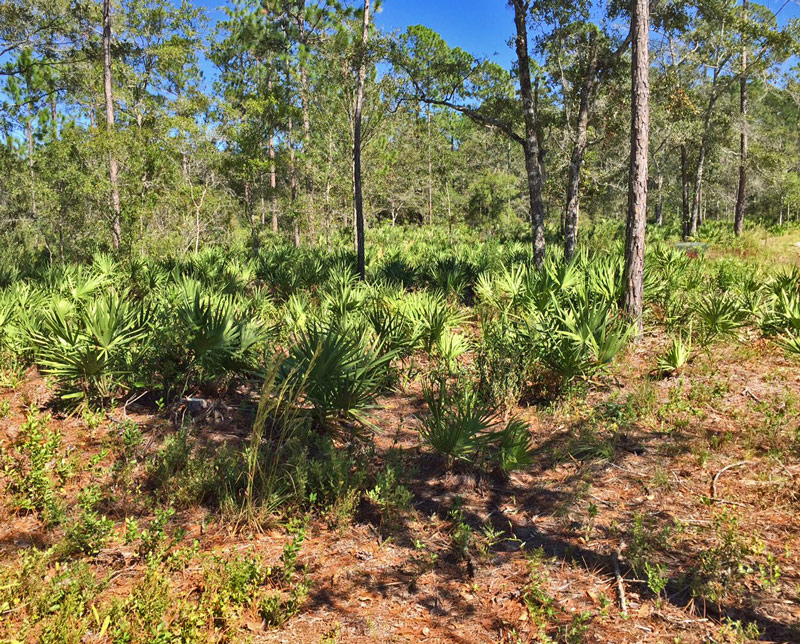
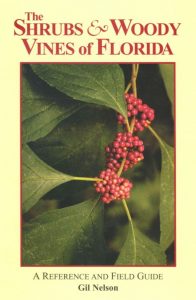
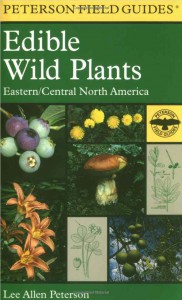
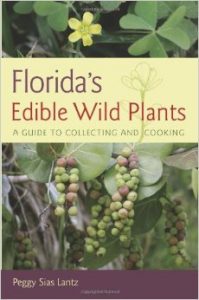
30 comments
We have some land just outside Florida that has some similar areas. I think David left out my favorite which is the Sand Plum or Chickasaw Plum. They tend to grow well and most of the fruit is really good. There are a few places that sell types selected for better fruit like “Guthrie” and others, but the standard seedlings seem to to fine.
You’re right – that’s a good species to include. You can also graft cultivated plums on top of them, using the Chickasaw as a rootstock.
In response to your email, I kind of miss seeing your daily post. I think you should just go ahead and post when you feel like it. That seems more like you than the structured, in the box, only posting at a certain given time.
GOD bless
Thank you, Rick – I appreciate it. I have thought about doing that, though I tend to be so unstructured that I miss things altogether unless I hold some schedule in my head. Heh. Really appreciate you stopping by.
I tried to email you to your address at the consulting link, but it got sent back saying:
“A message that you sent could not be delivered to one or more of
its recipients. This is a permanent error. The following address(es)
failed:”
Could you send me your email?
david@thesurvivalgardener.com. I might have a problem in my link – thank you for letting me know.
Don’t forget moringa and sweet taters, greens and tubers will grow in this sand as long as they get water once in a while.
Yes! Great suggestions. I’ve had trouble with sweet potatoes in poor sand but deep mulch makes a huge difference.
Sweet potatoes were a staple of the pioneers in Florida.They grew alot of greens in winter too.A method of improving soil: they would fence off a lot large enough for their garden, which had to be big,as that’s where all their food came from, and turn a few head of cattle in there for awhile.Am not sure how long, but at least a month.
.
With that much sand, check for root knot nematodes as one of the problems you face. Grow something super sensitive, squash or cucumbers is a good one. Give it good water, but pull it up after a month and look at the roots. If there are little bumps, or knots, all over the roots you are going to be fighting them as well. Research on the UF Extension website on plants that are super sensitive and avoid planting them in the ground. Container garden with good potting soil and your homemade compost instead.
Another great plant that likes your conditions is the native cocoplum. My kids like the soft fruit and the big seeds can be toasted and are a dead ringer for almonds in my opinion. It grows fast and makes a very pretty large hedge.
I have had great success with making melon pits for everything from trees to Seminole pumpkins. They hold the nutrients much better over time and can be planted again and again before topping with more compost.
Best of luck! Try not to get run-down about the challenges you are facing. I know Florida can present some seriously challenging obstacles, but once you master them, you’ll have beautiful gardens year round!
Nematodes are a serious thing to consider. Hawthorns and Chichasaw plums are, in my observation, very resistant and good rootstocks too… I should have mentioned in my post that the hawthorns need to be the native scrub types, not the ones that like lots of water.
Cocoplum might work but Les may be too far North. Very worth trying if this property is near enough to the freeze moderating effect of the ocean. I love them.
And YES on melon pits!
We live in that environment in SW Fl., 8 miles from the ocean. We tried cocoplum- they froze. Moringa grows- struggles. We mow the native weeds for a lawn – the other is too hard: water fertilizer, etc. Oranges, lemons, etc grow well. FL grapes. Fl low chill peaches. and loquat.
In ground gardening was impossible- nematodes, etc. Raised beds with commercial soil and irrigation do fair. The best are Earth Boxes- the brand…made by a FL gardener. We have 15 boxes. Home made and other brands haven’t been as successful. There are also racoons, fruit rats, birds, and ?? who eat the almost ripe stuff so we did a green house .
Sweet potatoes are good in the raised bed. Roselle [Jamaica] grows great in the ground. It makes a wonderful drink and jam. Easy here. Look on You Tube to learn about this. We are dehydrating ours. I bears repeated crops in the Fall here. You can save the seeds to replant the next season. In some countries the leaves are also eaten as a veggie or in a stew.
We have been composting for 11 years..all our veggie scrapes, and have only a 3×3 area improved. Too time consuming unless you have a source of clean compostable stuff.
Good Luck.
In addition to the good advice David has recommended, I would suggest Les starts to help nature fix the soil, in a big way. By introducing plants that will compete with the monocultural crops at present – even if they are native. Because a site which lacks diversity, is prone to only being able to produce the same survivors every year and the next extended dry period, just makes them more entrenched. But don’t remove what is already growing, until something else can be grown to replace them. Or you’ll work against your efforts to improve the soil.
That “something else” will have to be nitrogen fixing plants and even deciduous ones. These will be trees and shrubs, planted triple the amount than your fruit trees. Which is where your mulberry comes in. This will drop a phenomenal amount of leaf litter annually. What this leaf litter does, is start to feed the fungi that will start to detoxify your soils. Making way for other plants to start competing with the palmettos. There are plenty of hardy trees that will fix nitrogen for you too. A good one is leucaena, which has a reputation of growing in really arid conditions. But check their weed status in your State first. They make an awesome chop and drop material for mulching your fruit trees as well. In Australia we have something called a Casurina tree. It likes similar conditions to pine trees, looks very much like a pine tree too, but has the advantage of being a nitrogen fixer as well. It may be a matter of finding a variety of pine that fixes nitrogen. Or a relative to the pine family, that has more benefits than the ones you’re growing at present.
When you do come to the point you want to remove the palmettos though, use them as mulch material, or build a berm on the low side of your fruit trees, with their carcases, so they can help catch the moisture when it does rain.
While I’m in total agreement with David, there is only so much you can do to fight against your natural conditions, I’m also a firm believer that nature is all about succession too. And a site dominated by few species (such as yours) is a site in decline. So plant more nitrogen fixing and deciduous trees, than fruit trees, so they will become the tough nuts that hammer it out with the palmettos for real estate. They have the added benefit of improving your soils naturally too, so you’re not having to cart so much compost around. The trees are dropping it for you.
Les, if you can get a stand of nitrogen fixing and hardy deciduous trees to live on your land, then your fruit trees should do far better, incorporated on the edges or in between these guilds. Those nitrogen fixing trees will be far cheaper to buy than fruit trees, and have the benefit of being able to self replicate too. They are your canary in the mineshaft. Get them to succeed in numbers, and you’ll get your fruit trees to succeed in greater numbers too.
This is an awesome comment, Chris. I want to give you a million thumbs up. Great suggestions – thank you.
I’ve learned the hard way, not to just put fruit trees in a degraded site. ;)
This is very helpful–in fact it is right along the lines I was going–it seems eBay is a great seller of fresh seeds, and David site has listed some few, so as we write, several strange species (that are not illegal) are heading my way. Maybe I’ll find something that can make the palmettos unhappy. The only good thing about palmettos is that they grow back to resupply the ground every year–for now. And I won’t tear them out until I’m ready. Thanks for your help.
Have fun, Les. It may be a slow process, but you’ll see your land gradually improve, year by year. We attack an area at a time, when we plan to use the space. Then we push out to another area, from there. It’s a better use of resources, attacking a limited range at a time. Because you learn what works and what doesn’t, and can improve your strategies for the next land restoration project. :)
This is awesome David! Thank you! That list will be right where I start–and plum trees sound just fine–either wild or grafted. I’ve never figured out where the soil office is. They always recommend that place at the end of every single article! My wife will figure it out!
I did not buy the place for a food forest, but your list is a great start now that it’s the plan. I have built a tough chicken coop–hawks have been thinning the flock! No one here is excited about “meat birds” as all the hens all have pet names now… I’d like beef, but likely the cows would get names to.
I’m high on the blueberry plants–maybe they can grow here, and a mound would start well by burying some pines I’ve already cut…
It won’t look like your food forest, but over time–with your list, and buried trees, it will be more than pines and palmettos! The wetland area has some muck that might be useful. I’m grateful for your time–and embarrassed by my long note. Thanks much!
Look for the agricultural extension. They won’t give you the info that a pro lab will, though.
You will do GREAT with this property over time. Don’t get discouraged and improve piece by piece.
Also, this book really got me interested in the mineralization of the soil – great read: http://amzn.to/2e7lNRg
I’m totally in for small steps over long time–and learning the same way. I don’t even EAT vegetables–so I’m trying to learn how to eat them–so I’m guessing that with my starting point, and the incredible amount to learn, I’m quite some distance from getting to that soil detail text–though I can admire the mind that does dig that!
I’m going back to read all that up there (including the fantastic comments and suggestions–all of them) to get a bunch more out of it. I need to make notes. Build islands. Nitrogen fixers all over, sand nematodes, plum trees and local Hawthorne. My new focus has had a serious jump–I’ve got to find fun nitrogen fixers to get the family involved, for cheap. Thank you everyone!
What about starting Hugelkultur beds or even do straw bail gardening as options as wel.
Hugelkultur is a great idea! Straw bales are unfortunately iffy now. I love the concept, but a lot of the straw is now contaminated. Check this out: http://www.thesurvivalgardener.com/danger-of-straw-bale-gardening-no-one-is-mentioning/
I’ve been reading about Hugelkultur, but it seems more art than science. They say put trees in, then they talk about a mixture of “greens” too, some even suggest some kind of fungi should be introduced. I can bury trees–though they claim pine is a bad choice! Maybe some lime with the trees? One of the best ideas here is mounding up a bit to get away from my clay held false water level. Using Hugelkultur seems perfect–can anyone link me to a simple (or for the simple!) site on doing this? Otherwise I’m just going to bury some pines, and maybe throw in some palm fronds!
I know I’m a little late to this conversation, but what about buying some hogs, put up a temporary electric lined haddock, and letting those pigs do all the work for you? Some interesting books and videos on youtube, talk about clearing brush this way. Pigs will root up those palmettos, and leave plenty of bio waste to compost down, and enrich the soil.
I mean paddock, not a fish.
The Linda Duever link is dead but I believe the work in question is:
Ecology and Management of Saw Palmetto. Conway Conservation LLC. December 2011.
Alas,it no longer seems available online…
[…] is that many species might not like that scrubby land all that much. Here are some ideas that might help you pick easy ones for your area. I’m not sure if you have palmettos or not, but they’re a common understory for pine. […]
Possible? Sure. I’d just rather have native habitat than a food forest. I’d starve a thousand new yorkers to save one palmetto.
That’s not a bad ratio.
Comments are closed.